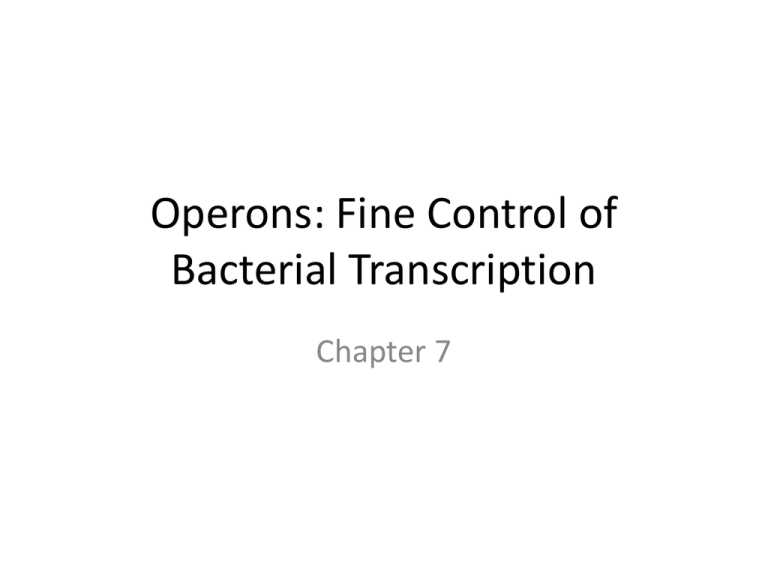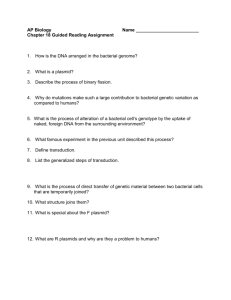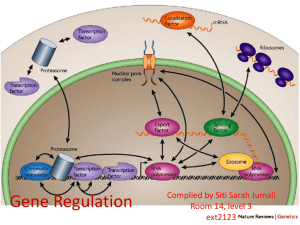Operons: Fine Control of Bacterial Transcription
advertisement

Operons: Fine Control of Bacterial Transcription Chapter 7 Why is Operon system important? • 3000 genes in E.coli – some products are in great demand • Some genes are turned off – rarely needed • Cannot leave all genes on all the time – takes energy for transcription and translation – drain cell of energy • Scientists – use Operon system The lac Operon • The lac operon - first operon discovered • Contains 3 genes coding for E. coli proteins that permit the bacteria to use the sugar lactose – Galactoside permease (lacZ) - transports lactose into the cells b-galactosidase (lacY) cuts the lactose into galactose and glucose – Galactoside transacetylase (lacA)- function is unclear lac Operon • All 3 genes are transcribed together producing 1 mRNA - a polycistronic message that starts from a single promoter – Cistron or gene - has its own ribosome binding site Control of the lac Operon • The lac operon is tightly controlled - using 2 types of control – Negative control - like the brake of a car - binds the repressor to the operator – Positive control – like accelerator pedal – removes repressor from operator – Activator - additional positive factor - responds to low glucose by stimulating transcription of the lac operon Negative Control of the lac Operon Negative Control of the lac Operon • Negative control - operon is turned on unless something turns it off and stops it • The off-regulation is done by the lac repressor – Product of the lacI gene – Tetramer of 4 identical polypeptides – Binds the operator just right of promoter lac repressor • When repressor binds the operator operon is repressed – Operator and promoter are contiguous – Repressor bound to operator prevents RNA polymerase from binding to the promoter • As long as no lactose is available - lac operon is repressed Inducer of lac operon • The repressor is an allosteric protein – Binding of one molecule (inducer – allolactose) to the protein (repressor) changes shape of a remote site on that protein – Altering its interaction with a second molecule (operator) Mechanism Summary • Two hypotheses of mechanism for repression of the lac operon – RNA polymerase can bind to lac promoter in presence of repressor • Repressor will inhibit transition from abortive transcription to processive transcription – Repressor by binding to operator blocks access by the polymerase to adjacent promoter Three lac operators • Three lac operators – The major lac operator lies adjacent to promoter – Two auxiliary lac operators - one upstream and the other downstream • All three operators are required for optimum repression • The major operator produces only a modest amount of repression Role in repression of transcription by the three operators Catabolite repression • When glucose is present - lac operon is in an inactive state • Selection in favor of glucose attributed to role of a breakdown product – Catabolite • Catabolite repression uses catabolite to repress the operon Positive Control of the lac Operon • Positive control of lac operon by a substance sensing lack of glucose activate lac promoter – The conc. of nucleotide cyclic-AMP - rises as the concentration of glucose drops Catabolite Activator Protein • cAMP added to E. coli can overcome catabolite repression of lac operon • Positive controller of lac operon has 2 parts: – cAMP + protein factor – Protein factor is known as: • Catabolite activator protein or CAP • Cyclic-AMP receptor protein or CRP • Gene encoding this protein is crp The Mechanism of CAP Action • CAP-cAMP complex binds to the lac promoter – Mutants whose lac gene is not stimulated by complex had the mutation in the lac promoter – Mapping the DNA has shown that the activatorbinding site lies just upstream of the promoter • Binding of CAP and cAMP to the activator site helps RNA polymerase form an open promoter complex CAP-cAMP complex • The open promoter complex does not form even if RNA polymerase has bound to the DNA - till the CAP-cAMP complex is also bound CAP • Binding sites for CAP in lac, gal and ara operons contain the sequence TGTGA – Binding of CAP-cAMP complex to DNA is tight • CAP-cAMP activated operons have very weak promoters – Their -35 boxes are quite unlike the consensus sequence CAP-cAMP Activation of lac Transcription • The CAP-cAMP dimer binds to its target site on the DNA • The aCTD (a-carboxy terminal domain) of polymerase interacts with a specific site on CAP • Binding is strengthened between promoter and polymerase ara Operon •The AraC - ara control protein, acts as both a positive and negative regulator •There are 3 binding sites • Far upstream site, araO2 • araO1 located between -106 and -144 • araI is really 2 half-sites – araI1 between -56 and -78 – araI2 -35 to -51 araCBAD operon The ara operon is also called the araCBAD operon for its 4 genes – Three genes, araB, A, and D, encode the arabinose metabolizing enzymes – These are transcribed rightward from the promoter araPBAD – Other gene, araC • Encodes the control protein AraC • Transcribed leftward from the araPc promoter Control of the ara operon AraC Control of the ara Operon • In absence of arabinose - no araBAD products - AraC exerts negative control – Binds to araO2 and araI1 – Loops out the DNA in between – Represses the operon • Presence of arabinose - AraC changes conformation – – – – It can no longer bind to araO2 Occupies araI1 and araI2 instead Repression loop broken Operon is derepressed Positive Control of the ara Operon • Positive control is also mediated by CAP and cAMP • The CAP-cAMP complex attaches to its binding site upstream of the araBAD promoter The trp Operon • The E. coli trp operon contains the genes for the enzymes - to make the amino acid tryptophan • The trp operon codes for anabolic enzymes • Anabolic enzymes are typically turned off by a high level of the substance produced • Operon - negative control by a repressor tryptophan levels are elevated • trp operon also exhibits attenuation Tryptophan’s Role in Negative Control of the trp Operon • Five genes code for the polypeptides in the enzymes of tryptophan synthesis – Chorismic acid • The trp operator lies wholly within the trp promoter • Presence of high tryptophan helps the trp repressor bind to its operator Negative control of trp operon • Without tryptophan no trp repressor exists -inactive protein - aporepressor • If aporepressor + tryptophan - changes conformation with high affinity for trp operator • Combine aporepressor and tryptophan to have the trp repressor • Tryptophan is a corepressor Mechanism of Attenuation • Attenuation imposes an extra level of control on an operon - more than just the repressoroperator system • Operates by causing premature termination of the operon’s transcript when product is abundant Defeating Attenuation • Attenuation operates in the E. coli trp operon as long as tryptophan is plentiful • If amino acid supply low - ribosomes stall at the tandem tryptophan codons in the trp leader • trp leader being synthesized as stalling occurs stalled ribosome will influence the way RNA folds – Prevents formation of a hairpin Overriding Attenuation Riboswitches • Small molecules can act directly on the 5’UTRs of mRNAs to control their expression • Regions of 5’-UTRs capable of altering their structures to control gene expression in response to ligand binding are called riboswitches • • • This project is funded by a grant awarded under the President’s Community Based Job Training Grant as implemented by the U.S. Department of Labor’s Employment and Training Administration (CB-15-162-06-60). NCC is an equal opportunity employer and does not discriminate on the following basis: against any individual in the United States, on the basis of race, color, religion, sex, national origin, age disability, political affiliation or belief; and against any beneficiary of programs financially assisted under Title I of the Workforce Investment Act of 1998 (WIA), on the basis of the beneficiary’s citizenship/status as a lawfully admitted immigrant authorized to work in the United States, or his or her participation in any WIA Title I-financially assisted program or activity. Disclaimer • This workforce solution was funded by a grant awarded under the President’s Community-Based Job Training Grants as implemented by the U.S. Department of Labor’s Employment and Training Administration. The solution was created by the grantee and does not necessarily reflect the official position of the U.S. Department of Labor. The Department of Labor makes no guarantees, warranties, or assurances of any kind, express or implied, with respect to such information, including any information on linked sites and including, but not limited to, accuracy of the information or its completeness, timeliness, usefulness, adequacy, continued availability, or ownership. This solution is copyrighted by the institution that created it. Internal use by an organization and/or personal use by an individual for non-commercial purposes is permissible. All other uses require the prior authorization of the copyright owner.



